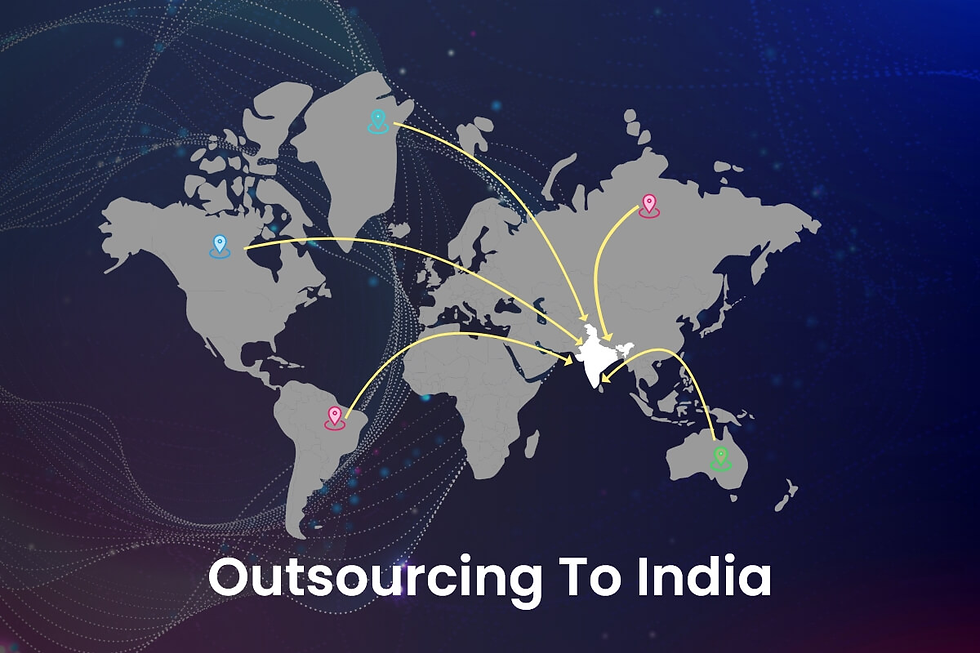Outsourced IT Support: A Complete Guide for Businesses in 2025
- Jayant Upadhyaya
- Aug 21
- 4 min read
Updated: Oct 14

Table of Contents
Introduction
What Is Outsourced IT Support?
Why Businesses Choose to Outsource IT
Types of Outsourced IT Support a) Managed IT Services b) On-Demand IT Support c) Co-Managed IT Services d) Cloud-Based IT Support e) Specialized IT Support
Benefits of Outsourced IT Support
Potential Drawbacks and Risks
Cost of Outsourced IT Support
Choosing the Right IT Support Provider
Best Practices for Managing an Outsourced IT Team
Alternatives to Outsourcing IT
Case Studies
Future of IT Outsourcing
Final Thoughts
1. Introduction
Technology now drives almost every business function — from communication and sales to analytics and security. But managing IT in-house can be expensive, resource-intensive, and distracting for small and medium-sized businesses. That’s where outsourced IT support comes in.
By working with a third-party provider, companies can access expert technical assistance, advanced tools, and scalable resources — often for less than the cost of hiring a full-time in-house team.
In this guide, we’ll break down what outsourced IT support is, the pros and cons, cost considerations, provider selection tips, and where the industry is headed.
2. What Is Outsourced IT Support?
Outsourced IT support is when a company hires an external service provider to manage some or all of its IT operations. This could include:
Helpdesk support
Network monitoring
Cloud management
Cybersecurity
Software installation and updates
Disaster recovery and backup
These services can be offered remotely, onsite, or through a hybrid model.
3. Why Businesses Choose to Outsource IT
Companies turn to outsourcing for many reasons:
Cost savings: Avoid salaries, benefits, and training costs of full-time staff.
Expertise access: Get specialized skills not available internally.
Scalability: Quickly adjust support levels as the business grows or contracts.
Focus on core business: Let internal teams concentrate on strategic goals.
24/7 support: Many outsourced providers offer around-the-clock helpdesk coverage.
Stat Check: According to Deloitte’s 2024 Global Outsourcing Survey, 59% of companies outsource to reduce costs, while 57% do it to focus on core business functions.
4. Types of Outsourced IT Support

a) Managed IT Services
A Managed Service Provider (MSP) takes over end-to-end IT management for a fixed monthly fee.
b) On-Demand IT Support
Pay-as-you-go support for specific issues or projects.
c) Co-Managed IT Services
A hybrid model where the outsourced team works alongside the in-house IT team.
d) Cloud-Based IT Support
Specialized support for cloud platforms like AWS, Azure, and Google Cloud.
e) Specialized IT Support
Niche services like cybersecurity monitoring, compliance audits, or custom software maintenance.
5. Benefits of Outsourced IT Support
Cost Efficiency Instead of paying for a full-time team, businesses only pay for the services they need. This makes Managed IT Services San Francisco a particularly attractive option for startups in the Bay Area looking to scale efficiently.
Access to Cutting-Edge Tools Providers often use enterprise-grade software and monitoring tools.
Improved Security Cybersecurity specialists help prevent data breaches and ensure compliance.
Proactive Maintenance Instead of waiting for problems to occur, MSPs monitor systems and prevent downtime.
Business Continuity Backup and disaster recovery solutions minimize downtime during outages.
Example: A Florida-based retailer switched to an MSP and reduced IT downtime by 40% while saving $60,000 annually.
6. Potential Drawbacks and Risks
a) Loss of Control You rely on a third party for essential systems.
b) Communication Barriers Different time zones or cultural differences may cause delays.
c) Security Concerns Sharing sensitive data with external providers poses potential risks.
d) Hidden Costs Some providers charge extra for emergencies, hardware replacements, or after-hours work.
7. Cost of Outsourced IT Support
The cost depends on:
Service scope
Business size
Location of provider
Level of expertise
Average Pricing (U.S., 2025): Managed IT Services: $100–$250 per user/month Hourly On-Demand Support: $100–$300/hour Project-Based Support: $5,000–$50,000+
Tip: Request a Service Level Agreement (SLA) with clear cost terms to avoid surprises.
8. Choosing the Right IT Support Provider
Assess your needs — Helpdesk? Cybersecurity? Cloud management?
Check their track record — Look for testimonials, case studies, and certifications.
Ask about security protocols — Ensure compliance with regulations like GDPR or HIPAA.
Evaluate their responsiveness — Ask about average response times.
Consider scalability — Can they grow with your business?
9. Best Practices for Managing an Outsourced IT Team

Set clear SLAs and KPIs.
Maintain regular communication.
Assign an internal liaison to coordinate with the provider.
Request monthly performance reports.
Conduct periodic security audits.
10. Alternatives to Outsourcing IT
In-house IT team — More control but higher costs.
IT consultants — Short-term, high-expertise hires for specific projects.
Hybrid IT model — Keep critical functions in-house and outsource the rest.
11. Case Studies
Case Study 1: SaaS Startup A San Francisco SaaS company outsourced its IT helpdesk and cloud monitoring to a remote MSP, cutting ticket resolution time by 55%.
Case Study 2: Healthcare Provider A Midwest clinic outsourced cybersecurity, ensuring HIPAA compliance and reducing attempted data breaches by 80%.
12. Future of IT Outsourcing
Trends shaping the next few years:
AI-driven IT support for faster problem resolution
Cybersecurity-first outsourcing
Increased demand for cloud-native MSPs
More SMBs adopting co-managed IT models
Forecast: The global IT outsourcing market is projected to reach $1.06 trillion by 2030 (Grand View Research).
13. Final Thoughts
Outsourced IT support can give businesses access to enterprise-level technology, expertise, and reliability without the full cost of an in-house team. The key is to choose the right provider, set clear expectations, and maintain oversight to maximize the benefits.
If you’re looking for reliable, cost-effective, and scalable IT support, Synlabs offers tailored outsourced IT solutions designed for both startups and growing businesses. Whether you need 24/7 monitoring, cybersecurity, or cloud management, Synlabs helps you stay focused on growth while we handle the tech.






Comments